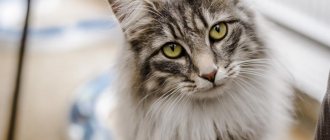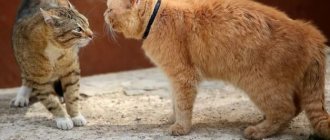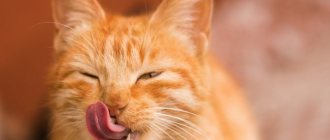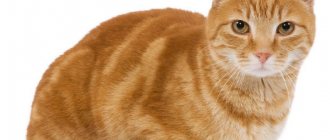In Ancient Egypt, cats were perceived as a divine animal. The myths and legends of Ancient Egypt endowed cats with positive human character traits. In addition, in Egyptian mythology it was believed that the cat has mystical powers and secret knowledge about the other world. Religious rituals were not complete without cats, and they also protected their owners and their homes from evil spirits.
Based on the hieroglyphs from the times of Ancient Egypt, we can conclude that regardless of whether the cat belonged to a domestic or wild breed, it was called “miu”, and the cat was called “miut”. There is an assumption that the origin of this designation for pets came from the meowing sounds made by animals. In addition, they could also call little girls whose character resembled cats - soft, affectionate, but at the same time cunning and smart.
Manifestation of the cat in the history of Ancient Egypt
Cats in Ancient Egypt were of two breeds: "Junk cat" or "African wild cat". They were the first domesticated pets to have their own owner. The process of taming the cat breed itself occurred gradually.
In those distant times, it was Egypt that was known throughout the world for its grain harvest. Small rodents often spoiled supplies, but it was noted that the cat of Ancient Egypt, as now, is an excellent mouse hunter. In addition, she often saved people from snakes, which she also deftly caught. So that the little predator continued to protect their home, people left them tasty, fresh fish. The cats gradually got used to this and became domesticated. This happened around 2000 BC.
Historically, it is known that during the New Kingdom, cats in Egypt were depicted on many objects, including even on the tombs of pharaohs or people of lesser fame. It often happened that these animals showed excellent hunting skills while hunting birds together with their owner or while fishing. There are many drawings where a cat sits next to the owner’s chair, personifying protection and friendship.
Something else interesting: Cat in China
How to choose a kitten
Have you already dreamed that an Abyssinian cat will appear at home?
It is better to buy it from breeders, since according to the advertisements “I will give away an Abyssinian”, “I will sell an inexpensive Abyssinian kitten”, “Abyssinian kitten for free” it is not a fact that you will get exactly an Abyssinian.
And the breeder is obliged to provide pedigree documents.
In addition, you need to see the mother cat, because the kittens of the Abyssinian breed are not at all like their parents: they are floppy-eared, clumsy, funny, they do not have that same royal grace.
Kittens of the Abyssinian breed are not at all like their parents: they are protruding, clumsy, funny, they do not have that very royal grace
The color will remain the same. Please note that there are no stripes on the front legs, the “necklace” should be solid, without breaks, so that the undercoat is not gray or very light.
The ticking should be noticeable and consist of two or three stripes, the pattern should be distinct, the eyelid and mouth should be edged in white with a transition to the chin and neck.
Abyssinian kittens can be given to new owners at 3 months of age. Previously it is undesirable, since his attachment to his mother is very great.
If you want to know how to determine the age of a kitten, we recommend reading the article
Otherwise, the physical and mental state of the baby will suffer.
The Abyssinian cat is quite playful. She can easily be lured by a fun game. That is why she has good relationships with children
Healthy kittens are active and playful, they are not aggressive or fearful. Choose a clean kitten with no unpleasant odor and shiny fur.
Ears and eyes should be clean, the tummy should be soft and without bloating. If a kitten has worms, it will be visible by its dense, seemingly full belly.
Check your vaccination passport: it should contain notes about injections given at 9 and 11 weeks of age.
Don’t forget to take documents: a veterinary passport, a card for issuing a pedigree, or the pedigree itself.
Consult with the breeder what to feed the kitten and how to care for it at first.
The Abyssinian cat, like any girl, loves to try on different looks.
You already know what color your Abyssinian cat will be; the price depends on the color (standards can be read at the beginning of the article) - keep this in mind.
The main characteristics of the breed: slimness, bordering on thinness, grace, majesty and size.
The cat is one of the sacred animals of Ancient Egypt
The Egyptian cat-headed goddess Bastet is one of the most popular goddesses worshiped by the ancient Egyptians. She personified fertility (of women and the earth), life, and home. Before cats were considered pets, Bastet was depicted with the head of a lioness or in the image of this animal. After 2000 BC, images of Bastet changed - she was painted with a cat's head or in the form of a graceful cat.
Bastet herself had black cats. The cat was also associated with Pasht (Moon), which among the Egyptian goddesses was the dark side of Bastet. In this regard, it was believed that the cat was directly connected with the Moon.
The cult of the cat in Ancient Egypt had a prominent representative - the city of Bubastis, where there was a temple dedicated to the goddess Bast. The residence of Shoshenq I was also located in this city. It was here that festive events associated with the cult of worship of the goddess with a cat's head took place. Later, it was here that the largest burial of cat mummies was found.
Goddess Bastet
Goddess Bastet
The goddess Bastet was the daughter of the great Ra, the sun god. Relationship with him is another reason to personify Bastet with a cat. The Book of the Dead says that the god Ra could change the shape of his eyes depending on the time of day: day - sun, night - moon. The eyes of a cat have the same property. Expanding during the day, they seem to accumulate sunlight. And this allows the predator to see at night.
The unique life of cats in Ancient Egypt
The whole world knows that the cat, the sacred animal of Egypt, was not only revered, but everything was done to preserve its better life. There are many facts that the sacred cat of the temple had not only the best food, which was grown especially for her, but also a person who devoted his whole life only to caring for her - organizing her rest, musical accompaniment, space. In addition, this profession was inherited and was considered one of the most important.
If a cat in the house got sick, the owner went to the temple for a sacrifice, which included livestock or a large share of the family’s supplies. The priests took the gift and asked the gods to heal the pet.
Something else interesting: Prophet Muhammad's cat
If the cat did die, then the whole family had to endure mourning, during which everyone prayed a lot, shaved their eyebrows and ate only very modest food. The funeral procession itself included mummification, after which the animal was placed in a coffin, decorated in accordance with the wealth of the animal's owner - the coffin itself was made of wood and decorated with gold, precious stones, carvings and various designs. For this reason, poor people did not keep a cat at home. Instead, they had figurines of this animal or the goddess Bast herself.
Killing a cat in Ancient Egypt was punishable by death or a very large fine. The severity of the punishment could be considered in accordance with the status of the pet's owner - if a person kills the ancient animal of a rich person, then one can receive a very severe punishment, up to and including the death penalty. In this case, the accident or premeditation of the murder did not matter.
Health and life expectancy
Sphinxes have a strong immune system, but there are also a number of diseases that are inherited:
- Myopathy – weak neck muscles; during life, the entire muscular system may weaken.
- Heart failure.
- Airway obstruction.
Such diseases appear at an early age, and the breeder must notify them in advance.
Sphinxes are also prone to the following diseases:
- turning of the eyelids;
- vasculitis – reddish or bluish dots appear on the skin;
- acne – appears due to strong production of subcutaneous sebum;
- conjunctivitis;
- dermatitis.
If properly maintained, the average lifespan of a Sphynx is 14–17 years.
A modern take on the cat in Egypt
The cat of Egypt traveled from deity to squalor over several thousand years. Now these graceful animals are not so seriously revered. Many street cats have learned to live together even with dogs. In hotels you can find many cats roaming around freely. They are fed and cared for by local staff. At the same time, they are very affectionate and kind to every guest. Some streets are so filled with cats that it is impossible to step on them without hitting the graceful predator.
Many visitors to Egypt consider local cats to be too skinny and, at first glance, they seem to be abandoned. However, this is not quite true. The real Egyptian cat has a rather thin build, with long legs and a slightly elongated muzzle. Their fur is quite short. Such changes in the physique of many pets are associated with the climate of Egypt. But you can also find plenty of fluffy felines there, because the first cats were brought from Persia.
Features of care
Combing
The Abyssinian's coat is short, so it does not require special care.
Going through the fur with a furminator once a week is more than enough.
During molting, it is better to bathe cats more often to wash away dead hairs - pets respond favorably to the procedure.
Trim your nails before bathing. They can polish them on a scratching post - don’t forget to buy one.
To maintain physical fitness and direct your cat’s activity in the right direction, often play with your pet: balls, wind-up mice, a yo-yo, or just a bow on a string.
The ears of Abyssinian cats are large, so they should be cleaned regularly to avoid the development of infections.
Clean with a cotton pad or a damp cloth once every two weeks.
To make cats feel calm, allocate a place in the room for a house or bed. Don't forget about toys.
You can read about how to make a cat house with your own hands here:
Walk
Today Abyssinian cats are domestic cats. That's why they are not walked on the street. However, if you do take your pet out, put a flea and tick collar .
They have enough walking around the entire house, wherever the owner goes.
To maintain physical fitness and direct activity in the right direction, often play with your pet: balls, wind-up mice, a yo-yo, or just a bow on a string.
The Abyssinian cat constantly lacks attention. She will follow you everywhere: into the room and corridor, onto the balcony and into the kitchen. When meeting its owner, the cat will invariably say hello by purring affectionately
Nutrition
Abyssinians are real picky eaters, as befits royalty.
But if they like the dish, problems with collecting food can be avoided.
The Abyssinian cat's diet should be balanced, rich in vitamins, minerals and various microelements.
All this is contained in ready-made wet and dry food .
As for natural food, feed them three times a day. And don't forget about clean water.
Abyssinians are real picky eaters, as befits royalty.
- Like all predators, Abyssinians love meat. Give 100-140 g of meat per day: beef, veal, minced meat or chicken, chicken (but without bones), offal (if your pet likes them). Alternate meat products to diversify your diet.
- A couple of times a week, a raw or soft-boiled egg.
- Cereal porridges that do not cause bloating.
- Fermented milk products, milk.
- Vegetables, raw or cooked.
- Fruits. Some cats of this breed love melons and bananas.
- You should not give fatty pork, legumes, oatmeal, river fish, food from the table, and even seasoned with spices.
The Abyssinian's coat is short, so it does not require special care. Going through the fur with a metal fine-tooth comb once a week is more than enough.
King Cambyses
Rider on a horse
In 525 BC. e. in the city of Pelusium (now Port Said), the worship of cats led the Egyptians to misfortune. Persian troops did not know how to storm besieged cities. The ingenuity of King Cambyses helped. He ordered each warrior to hold a cat in front of him during the assault. The Egyptians did not dare to risk the lives of divine animals and surrendered without a fight.
Thus, graceful, capricious and mysterious animals decided the destinies of many people for a long time. And now cats can be found in almost every family. They are looked after. They are loved. They are revered.
Recommended by topic
Anubis Sphinx Isis
In addition to all her areas of responsibility, Bastet was in demand and adored not only by people, but also by the gods. It was she who was part of the guard of the supreme god Ra when he sailed on his boat across the sky, and at night in the underworld. In the guise of Sekhmet, Bastet was one of those who protected Ra from the serpent Apophis, whom the sun god encountered every night in the underworld.
The attributes of the goddess were an aegis in one hand and a sistrum in the other. Bastet was often attributed to a basket (a symbol of the harvest), as well as amulets with cats (which were incredibly popular in those ancient times). This spoke completely about the character and significance of the goddess. On the one hand, Bast had an easy disposition, loved dancing, fun and celebrations, and on the other hand, she was unforgiving if it was necessary to punish someone.
Due to Bastet’s connection with the sun and moon, it was believed that she had incredibly powerful intuition, and even the gift of prediction, which was used more than once by both people and gods. And the most interesting thing is that the star Sirius was considered the symbol of the goddess, around which many secrets revolve around the pyramids and the Great Sphinx.
They say that the sound of the sistrum had amazing magical properties. He was able to heal people, give them back the meaning and purpose of life, and was able to heal both soul and body. As we said earlier, very often Bast was depicted surrounded by 4 cats, symbolizing the directions of the goddess’s work: fertility, female childbirth, patronage of marriage and motherhood.











